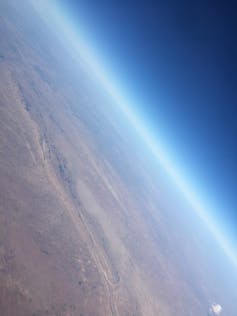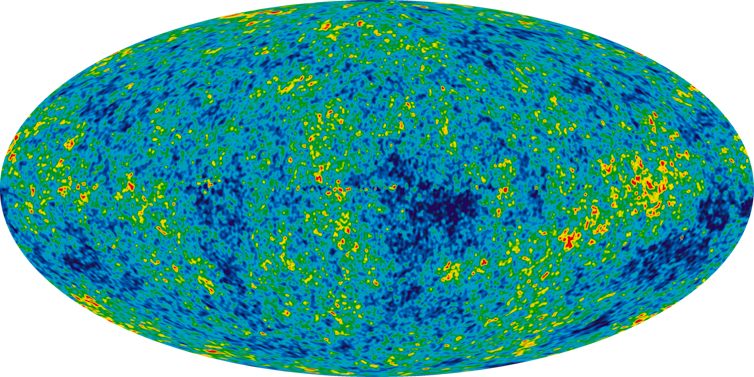
Curious children is a series for children of all ages. If you have a question you’d like an expert to answer, send it to curiouskidsus@theconversation.com.
What is space made of – what does gravity really bend? – Phil, 12, Birmingham
What comes to mind when you think of space? Imagine a friend bragging about a big building, stadium, or museum they recently visited. Do you imagine the building as big and wide? Is it simply too big or does it look empty?
The word spacious does not necessarily mean empty. This simply indicates that there is enough space to move around the objects inside. Similarly, outer space is not completely empty. It’s vast and forever expanding, but there’s so much in it.
As a child, I wondered about questions such as the distance of clouds, what lies beyond the earth, and the vastness of space. This curiosity led me to pursue a master’s degree and a Ph.D. degree in astronomy.I have been teaching these concepts for two decades as a professor of physics education at the University of Texas, Arlington.
Where does space begin?
The earth is surrounded by different layers of different gases. At sea level, the Earth’s atmosphere contains about 100 billion molecules per cubic centimeter. As it rises, the atmosphere becomes thinner and thinner.

Mohatatu/Wikimedia Commons, CC BY-SA
At an altitude of about 50 to 62 miles (80 to 100 km), there is not enough air for airplanes to fly. This boundary that separates the Earth’s atmosphere from outer space is called the Karman line, named after the Hungarian-American engineer and physicist Theodor von Karman. Everything above our line of work is called space.
The density of space can vary, but, on average, it is only about 1 atom per cubic centimeter. Just imagine – a dice-sized cube of Earth’s atmosphere contains billions of air particles. But in space, a cube of the same size has only one or two particles.
Interstellar medium and radiation
Space, or outer space, is a vast, nearly perfect void that is largely devoid of matter. This vacuum has very few particles compared to the Earth’s atmosphere. However, it is not completely empty.
Space is full of diffuse matter called the interstellar medium, which consists of hydrogen and helium atoms. These are the most common elements in space and exist in both charged and neutral forms. The interstellar medium also contains cosmic dust – tiny particles of various elements, including carbon and silicon, scattered throughout space.
Energetic particles called cosmic rays—which are primarily protons and the nuclei of atoms—travel through space at nearly the speed of light. Cosmic rays come from various stars, including our Sun, as well as from supernovae, matter falling into black holes, colliding galaxies, and more.

NASA/WMAP Science Team
Space is full of various forms of radiation, including the cosmic microwave background radiation. This is the residual heat from the origin of the universe. High-energy cosmic events such as supernovae and black holes also emit X-rays and gamma rays.
Magnetic fields produced by stars, planets and many other celestial bodies also permeate space. These fields affect the movement of charged particles by attracting or repelling charged particles like a magnet.
Dark matter and dark energy
Scientists predict that an as-yet-unseen form of matter that does not emit light or energy, called dark matter, makes up a significant portion of the mass of the universe. Researchers speculate that it exists because they can see its gravitational pull on other visible matter.
Similarly, scientists predict that a mysterious form of energy called dark energy is driving the accelerated expansion of the universe. Unlike dark matter, dark energy is not related to matter or gravitational forces, but is a property of space itself.
Imagine the universe as a balloon. Dark matter is like the material in a balloon that affects its shape, while dark energy is like the air that is pumped into it. It does not change the material of the balloon, but it affects the rate of expansion of the balloon.
Does space distort? Can gravity bend space?
Space can also be distorted. Imagine that the space is like a big and elongated trampoline. If you place a heavy ball like a bowling ball in the middle of the trampoline, it will make a big downward slope. This tilt is similar to the rotation of space around something large, such as a planet or a star. The bigger the ball, the stronger the gravity and the deeper the slope.
If you roll a smaller marble onto a trampoline and place a bowling ball in the center of it, the marbles may begin to roll around the slope created by the bowling ball’s gravity. Marble follows the curve of the slope, just as the planets follow the curve of space around the sun.
Imagine shining a flashlight on a trampoline. If the light approaches the slope created by the bowling ball, it may bend slightly as it moves. This is similar to how light bends when it passes near a very large object in space, such as a galaxy.
Think of a black hole with massive gravity as an even bigger and deeper depression in a trampoline. If you roll a marble too close to this incredibly deep slope, it will fall in and disappear, just like how objects can be pulled into a black hole in space and unable to escape.
Therefore, space can bend or bend around large objects that have a lot of gravity, just like a trampoline bends when you put a heavy ball on it.
Space is more than emptiness. It involves a combination of particles, radiation, magnetic fields, and mysterious forms of matter and energy. Think of space as a 3D playground where objects like stars, planets, nebulae, and galaxies exist and together make up our fascinating and complex universe.
Hey curious kids, do you have a question you want an expert to answer? Have an adult submit your question to CuriousKidsUS@theconversation.com. Please tell us your name, age and city where you live.
And since curiosity knows no age limit—adults, let us know what you’re wondering. We won’t be able to answer every question, but we’ll do our best.
#space #astrophysicist #explains #radiation #dark #matter #vacuum #space